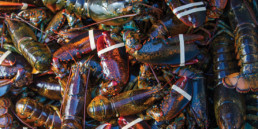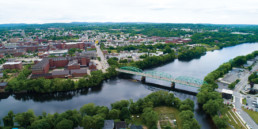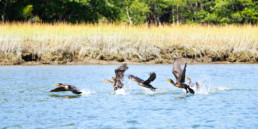All eyes on the Chesapeake
Estuary’s recovery faces political and legal challenges
By Jeremy Cox
The Chesapeake Bay’s past is the stuff of legend: Pocahontas and Capt. John Smith (well, actually John Rolfe), the rockets’ red glare and the anthem it inspired, the Monitor and the Merrimack, oyster pirates and the “Oyster Navy.”
The future, though, is shaping up to be the stuff of hard science: nitrogen and phosphorus, the Watershed Model and the SPARROW model, secchi disks and conductivity sensors, stock assessments and consensus-based fishery management plans.
The Chesapeake is the subject of one of the longest-running and most complex environmental restoration efforts in history. Over the past five decades, the region has evolved into one of the world’s premier testing grounds for water-quality monitoring methods, stormwater runoff fixes, and a whole host of other ecological practices.
If that were the end of the story, the bay might regain its health after all. But it’s not.
The cleanup will have to navigate through politics, legal turmoil, and funding disputes. Therein lies the biggest test of all: whether the cooperation that has largely marked the recovery of America’s largest estuary remains steadfast or fractures apart.
“To me, all eyes are on the Chesapeake,” said Ann Swanson, longtime executive director of the Chesapeake Bay Commission. “With the state brain trusts and strong federal involvement, if they can’t do it, who can?”
The Bay Commission is an embodiment of that cooperative spirit—an advisory board largely consisting of state lawmakers from Maryland, Pennsylvania, and Virginia. The commission provides a platform for the states to cultivate collective policy, said Swanson, who has led the board for 33 of its 41 years.
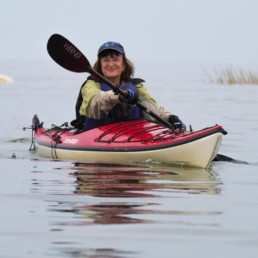
Ann Swanson
Photo: Dave Harp
“If we say we want a ban on firefighting foam, our members in each of the states can each file legislation,” she added. “They don’t have to lobby someone else.”
From the Great Lakes to south Florida’s Everglades, aquatic ecosystems are grappling with a crisis of overabundance. Too much fertilizer spread on farm fields and suburban lawns. Too much silt unloosed by poorly managed construction sites and cropland left uncovered during the winter. Too much population growth transforming wetlands and forests —nature’s pollution filters—into subdivisions and 7-Elevens.
Only it’s worse for the Chesapeake. The bay’s watershed measures about 64,000 square miles. A drop of water can fall as far north as Cooperstown, N.Y., as far west as West Virginia’s Blue Ridge Mountains, and as far south as Virginia Beach, Virg., and eventually trickle into the bay. The bay itself, though, only covers about 4,500 square miles of surface. That 14-1 land-to-water ratio is like an area the size of Missouri draining into Connecticut. Because of the Chesapeake’s relative shallowness and gentle tides, whatever ends up in its waters tends to stay there for at least six months before flushing out to sea.
So, what happens on the land, marine scientists say, profoundly influences the bay’s water quality.
And it has. Tidal waves of nutrients trigger annual blooms of algae that suck up oxygen as they die off. In deeper parts of the bay, this creates “dead zones,” where creatures large and microscopic perish unless they’re able to flee. Meanwhile, sediment injections turn the water from clear to murky, blocking sunlight from reaching the underwater grasses that are the nurseries for many fish species.
For much of the 20th century, the bay’s decline was so gradual that the alarm bells that some scientists had begun to ring went unheeded. A long drought in the mid-Atlantic through much of the 1960s helped keep the pollution under wraps. When that noxious buildup was finally unleashed in 1972 by Tropical Storm Agnes, the results were ecologically catastrophic. To this day, the bay has yet to fully recover from the storm’s effects.
But those storm clouds contained a silver lining. Shocked into action, Congress approved a five-year, $27 million study to pinpoint what was wrong with the bay. Its publication in the early ‘80s led to the creation of the Chesapeake Bay Program, a federal and multi-state partnership to oversee its restoration.
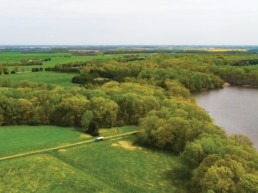
Chestertown, Md. is home to a variety of farms, from dairy to vegetables. The runoff from these fields goes into the Chester River which empties into Chesapeake Bay.
For many years, the restoration was plagued by inadequate funding and weak oversight. There were key improvements in wastewater discharges and a significant reduction in nitrogen from cleaner air quality. But progress was painfully slow. So, in 2010, the partners finally agreed to a strict “pollution diet,” which called for steep reductions in nutrient and sediment.
The agreement created federal “backstops” to prod laggard states forward. And it set a 2025 deadline for all projects and regulations to be put in place.
The Bay Program has already fended off one major attempt to undermine its efforts. Several agricultural trade associations and the National Association of Home Builders filed a lawsuit just weeks after the 2010 agreement was announced, claiming that the EPA overstepped its authority. They were later joined by attorneys general from 21 states (notably, only one was based in the watershed). The Third Circuit in Philadelphia upheld the agreement in 2015, and the Supreme Court allowed that decision to stand when it declined to hear the case the following year.
The partnership worked on the restoration throughout the legal battle and hasn’t let up since it ended.
Since 2015, state and federal spending on the cleanup has averaged about $1.7 billion per year.
Across the region, many farmers plant “cover crops” to prevent topsoil from washing away during the winter. Ranchers are fencing off streams to stop cattle from defecating directly in the water. Counties and cities are transforming ditches into winding streams to deflect nutrients and sediment off their journeys to the bay. Community programs encourage homeowners to install rain barrels on their downspouts to reduce stormwater runoff during peak flows. Chicken manure, once spread as fertilizer on adjoining corn and soybean fields, is hauled to less-sensitive farming areas.
Since 2015, state and federal spending on the cleanup has averaged about $1.7 billion per year. That figure doesn’t account for local expenditures.
That investment, however, has yielded little progress where it matters most: the ecosystem’s health. The Chesapeake Bay Foundation, the region’s leading environmental group, has been tracking the restoration’s progress since 1998, issuing a “State of the Bay” report every two years. The group’s scientists distill more than a dozen indicators into a single “index score” between 1 and 100, with 70 or above considered “saved.”
The inaugural report more than 20 years ago gave the bay a score of 27. In the latest, published in January 2021, it received a 32.
“We’re still not close,” said Don Boesch, a marine scientist and former president of the University of Maryland Center for Environmental Science. The agricultural sector needs to make up the most ground to meet its pollution-reduction goals, he noted.
“We’ve required various practices that we think would have beneficial effects, and we’ve paid people to do things. But they weren’t very effective or they weren’t implemented appropriately.”

Don Boesch
Photo: Dave Harp
For years, downstream states have pointed to a lack of progress made by Pennsylvania and New York to reduce nutrient and sediment runoff. Last September, that frustration boiled over into a full-blown legal showdown. Virginia, Maryland, and the District of Columbia filed a federal lawsuit alleging that the EPA hasn’t adequately enforced pollution controls in the two northern states.
The 2025 cleanup goals were already unlikely to be met. The Chesapeake Bay’s long-term rebound now appears to hinge on whether the states that depend on its health can agree to continue riding in the same boat or abandon ship.
Jeremy Cox is a reporter for Bay Journal, a nonprofit publication that covers the environment of the Chesapeake Bay region.



